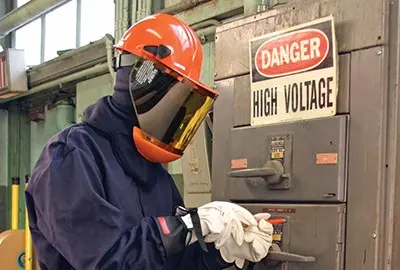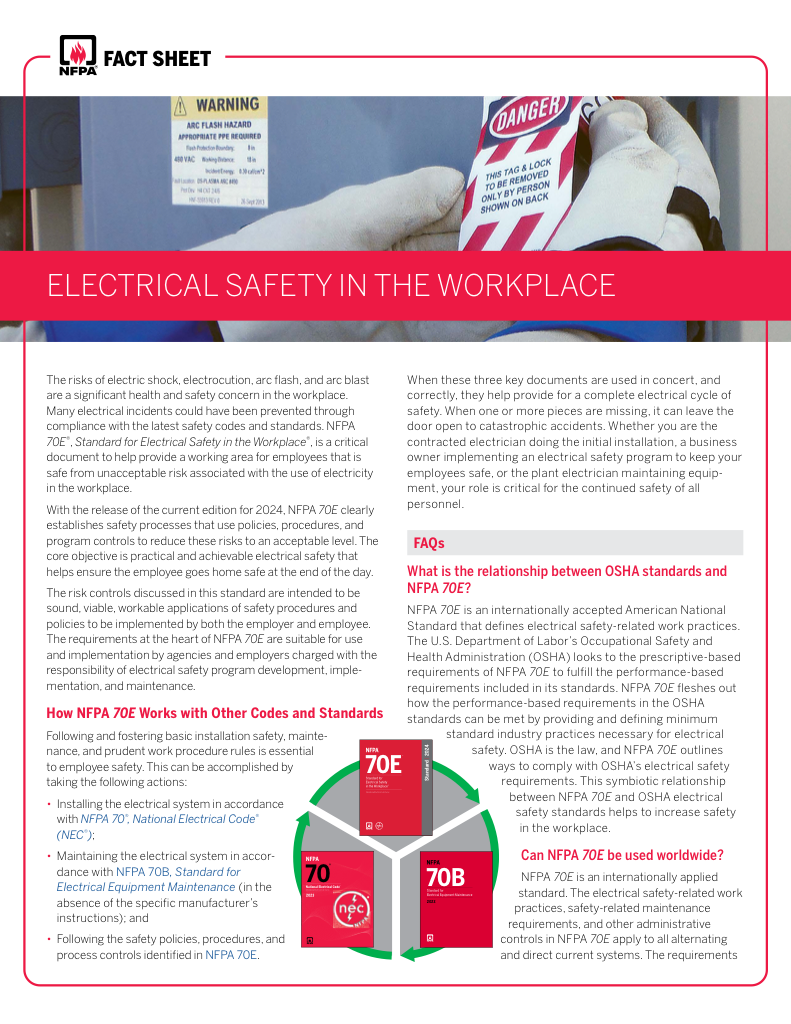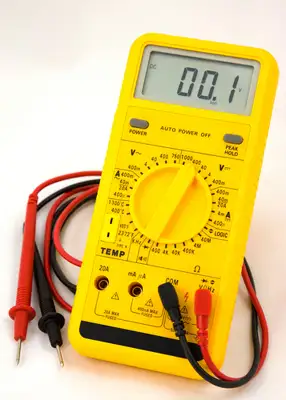Arc Rated Clothing for Electrical Workers
By R.W. Hurst, Editor

NFPA 70e Training - Arc Flash
Our customized live online or in‑person group training can be delivered to your staff at your location.

- Live Online
- 6 hours Instructor-led
- Group Training Available
Download Our NFPA 70E Fact Sheet – 2024 Electrical Safety Edition

- Understand how NFPA 70E works with NEC and NFPA 70B standards
- Clarify the shared responsibility between employers and employees
- Learn how NFPA 70E supports OSHA compliance
Arc rated clothing delivers arc flash protection using FR fabrics meeting NFPA 70E, OSHA, and CAT ratings, helping electricians and utility workers reduce thermal hazards with compliant PPE, ATPV performance, and electrical safety standards.
Understanding Arc-Rated Clothing in Electrical Safety
Arc rated clothing is personal protective equipment (PPE) designed to shield workers from the intense heat and thermal energy produced during an accident. Unlike general flame-resistant (FR) gear, arc rated (AR) clothing is tested for its ability to resist ignition and insulate against high incident energy levels measured in calories per square centimeter (cal/cm²). Employers must provide this PPE based on the results of a hazard risk assessment, in accordance with NFPA 70E and CSA Z462 standards. For practical definitions and examples of garment performance, see our arc flash rated clothing overview for grounding your PPE program.
This kind of protective clothing must match the task's specific hazard level, including considerations for fabric type, number of layers, and arc rating (ATPV or EBT). Selecting the right gear is critical for worker safety and regulatory compliance. This guide explains how ratings are determined, what materials meet standard requirements, and how to choose the proper clothing for your electrical work environment. You can explore selection checklists and common fabric options in our arc flash clothing resource for applied guidance.
Request a Free Training Quotation
Understanding the categories of AR clothing is essential for selecting the appropriate level of protection. These categories—ranging from CAT 1 to CAT 4—are based on incident energy levels determined during a power system study. Each category specifies the minimum arc rating (in cal/cm²) required for the PPE, along with guidelines for shirts, pants, coveralls, hoods, and face protection. For a detailed overview of clothing requirements by cal/cm² and task-based protection levels, refer to our Arc Flash PPE Requirements Chart and our Arc Flash PPE guide.
Sign Up for Electricity Forum’s Arc Flash Newsletter
Stay informed with our FREE Arc Flash Newsletter — get the latest news, breakthrough technologies, and expert insights, delivered straight to your inbox.
Understanding how minimum cal/cm^2 values are set is easier when you review our arc flash rating explainer for testing methods and thresholds.
What Makes Clothing Arc Rated?
AR clothing is specifically engineered to withstand the thermal hazards associated with electrical faults. The key factor that differentiates AR clothing from other types of PPE is its ability to resist ignition and provide thermal insulation. This clothing is made from flame-resistant (FR) fabrics that do not melt, drip, or support combustion. These materials undergo rigorous testing to determine their rating, which measures the amount of thermal energy the fabric can withstand before the wearer sustains a second-degree burn. The higher the rating, the greater the protection offered by the clothing. To learn how basic arc-rated garments are applied in practice, visit our detailed guide on Arc Flash Category 1 PPE. For context on how those ratings are calculated in the lab, consult how arc rating is derived for a step by step view.
What is True for AR Clothing?
Several characteristics are true for AR clothing, ensuring it provides effective protection in hazardous environments:
-
Flame Resistant: AR clothing is inherently flame resistant, meaning the fabric's properties are built into its fibers and do not wash out or wear away over time. This ensures long-lasting protection throughout the garment's life.
-
Durability: High-quality AR clothing, such as those produced by National Safety Apparel, is designed to withstand the rigors of industrial work environments. The clothing maintains its protective qualities even after repeated laundering and heavy use.
-
Comfort and Fit: Modern AR clothing is designed with both safety and comfort in mind. Ergonomic designs and breathable fabrics ensure that workers can wear the gear for extended periods without discomfort, which is crucial for maintaining compliance with safety protocols.
-
Layering: AR clothing can be worn in layers to increase protection. For instance, a flame resistant base layer can be worn under an AR outer layer to enhance thermal insulation and protection. For wardrobe planning across seasons, see arc flash PPE clothing suggestions that balance comfort and protection.
Each PPE category, from CAT 1 to CAT 4, defines the minimum level of thermal protection required—learn how to meet these standards with our
Arc Flash PPE Categories resource.
How to Verify Arc Rated Clothing?
Verifying the authenticity and effectiveness of AR clothing is crucial to ensure worker safety. Here are some steps to verify arc rated clothing: Electricians and supervisors can follow the check process outlined in arc flash clothing for electricians to standardize documentation reviews.
-
Check Labels: Genuine AR clothing will have labels indicating its rating, compliance with safety standards, and care instructions. Look for labels that specify compliance with standards such as NFPA 70E or ASTM F1506.
-
Manufacturer Certification: Reputable manufacturers like National Safety Apparel provide certification and documentation for their AR clothing. Verify that the clothing comes with proper certification and documentation.
-
Independent Testing: AR clothing should undergo independent testing by accredited laboratories. Look for certifications from recognized testing organizations that confirm the clothing's rating and flame-resistant properties.
-
Durability Testing: Verify that the clothing has been tested for durability and maintains its protective qualities after multiple washes. This information is usually available in the manufacturer's product specifications. Visit our page on Arc Flash Clothing for Electricians for more information about how they should verify the authenticity of their ppe.
What is the Standard for Arc Rated Clothing?
Several standards govern the design, testing, and performance of AR clothing to ensure it provides adequate protection. The primary standards include: When aligning PPE selections to tasks, reference the arc flash PPE category framework to confirm minimum ratings and ensembles.
-
NFPA 70E: The National Fire Protection Association (NFPA) 70E standard provides guidelines for electrical safety in the workplace. It includes requirements for the use of AR clothing as part of a comprehensive PPE program. The standard specifies the minimum rating required for clothing based on the level of electrical hazard present.
-
ASTM F1506: The American Society for Testing and Materials (ASTM) F1506 standard specifies the performance criteria for textile materials used in AR clothing. This includes tests for flame resistance, rating, and durability. Compliance with this standard ensures that the clothing provides reliable protection.
-
OSHA Regulations: The Occupational Safety and Health Administration (OSHA) regulates employers' provision of appropriate PPE, including AR clothing, to protect workers from electrical hazards. OSHA references NFPA 70E and other standards to define the requirements for PPE.
-
IEC 61482: The International Electrotechnical Commission (IEC) 61482 standard specifies requirements for clothing to protect against thermal hazards. This standard is widely recognized and used internationally.
AR clothing is an indispensable part of personal protective equipment for workers exposed to electrical hazards. Its flame-resistant properties, durability, and compliance with rigorous safety standards ensure that it provides effective protection in hazardous environments. By understanding what makes clothing AR, verifying its authenticity, and adhering to established standards, employers can ensure the safety of their workers. Whether through the guidelines of NFPA 70E, ASTM F1506, or other recognized standards, maintaining high protection standards is essential for workplace safety.
Electricity Today T&D Magazine Subscribe for FREE

- Timely insights from industry experts
- Practical solutions T&D engineers
- Free access to every issue
Related Articles:








